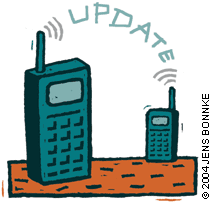
Providing simple updates can relieve worried patients, calm stressed-out colleagues and give you peace of mind.
Fam Pract Manag. 2004;11(10):84

It’s 10 a.m. on Monday, and you already have an overflowing to-do list with dozens of people waiting for you to reply to their requests or to take action on a project. You can’t do everything at once, so what should you do?
Depending on the nature and seriousness of the request or task at hand, your best strategy may be to provide updates. No one should be left wondering about the status of a project or request.
Updates serve many purposes:
1. They relieve stress and worry. Most of us do not do well with a state of suspension. We need to know something even if there is little new information. In fact, simple updates may be one of the kindest things you can do for your patients. You can probably recall the look on a patient’s face after she had just been told, “We don’t have your test results yet, but you will hear from me personally by Friday.”
2. They save time. When we fail to keep one another apprised of changes in a project or task, we waste valuable time and energy. For example, a patient or colleague waiting for a return call may phone your office several times over the course of the day, which costs staff time and resources.
3. They reduce conflicts. Stress and worry can lead to anger and conflict when individuals are not informed of changes or the current status of a situation. This is especially true in situations that directly affect a person’s sense of safety, worth or well being.
Updating the update
Updates are now easier to do than ever before thanks to the same technologies that have also complicated our lives. For example, short, concise e-mails or voicemails are an easy way to deliver an update: “I got your request this morning and will get that information to you by Tuesday before lunch.” Such specificity might not always be possible, but you should at least let the other party know that you received his or her request and you plan to take action soon. If your plans change, the update is more essential than ever. No one should be surprised.
If you are working closely on a project with another individual, you might even want to develop your own system for updating one another. For example, you could agree to use a pager code to update each other on the project’s status. Code #12345 might mean, “Got your message; will proceed.” Check your cell phone to see whether you have “quick notes” or text messaging, which can accomplish the same purpose.
If you sense that the update requires the reassurance or clarification that only the human voice can provide, talk to the person directly either via the telephone or in person. Never hide behind e-mail or voicemail if the update is unpleasant or conflictual. This kind of update is almost as damaging as no update at all.
Where possible, delegate updates to your staff. For example, if your office is running behind, you can actually win points and respect from your patients if your staff members update them about any delays. This is almost a required courtesy these days.
Just do it
Never underestimate the power of the update in developing loyalty and respect from patients, staff and colleagues. You may not be able to complete every item on your to-do list in a single day, but it’s a good feeling to know that everyone has been brought up to date. It will ease your mind, and theirs. It does not matter how you update, but that you update.